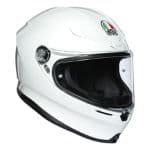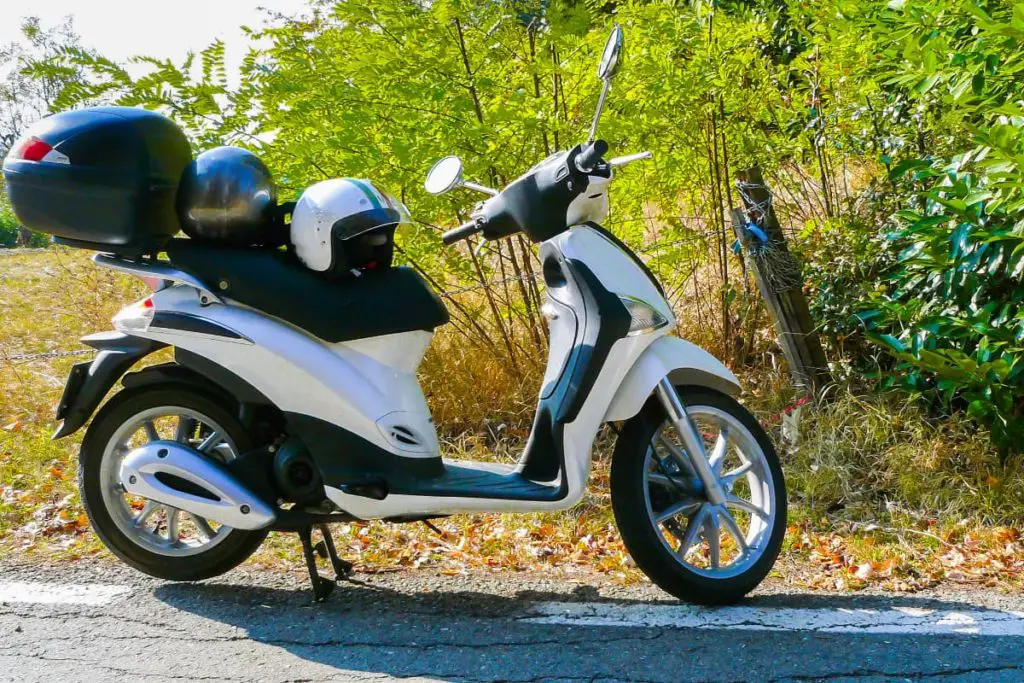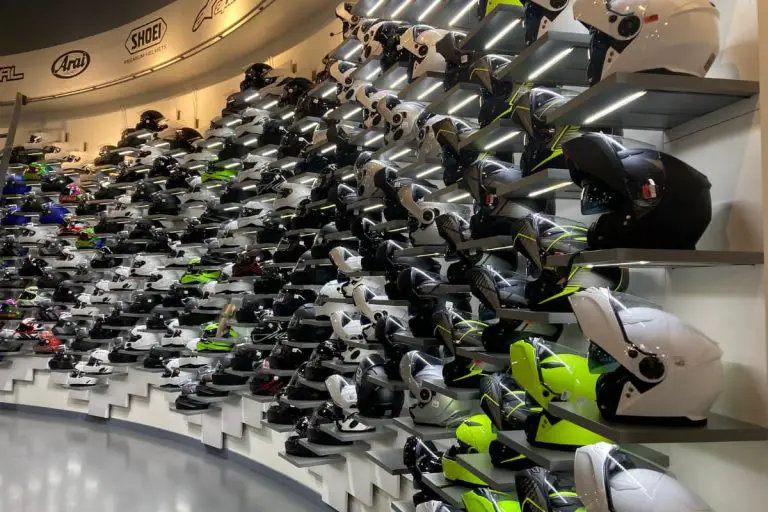Visibility is something that most riders fail to consider when buying their helmet. An important question to ask when getting your helmet is ‘how visible will this helmet be, particularly in the dark or low light?’
Visibility is a key factor in many accidents, but good news! You can impact your own visibility in some ways like considering how well you are seen by what you wear – including your helmet!
In general, the lighter the color the better in regards to visibility, so this makes white the best motorcycle helmet color for visibility.
A visible helmet is as important as the helmet itself. As a motorist, if you are looking to get a new helmet and do not know what to go for, keep reading as we will discuss all you need to know about getting a helmet in detail.

Click to see my fav white helmet
Lightweight, breathable, & available in white
Does the Color of a Motorcycle Helmet Even Matter?
Black helmets certainly feel like the norm as the most popular color, but that is mainly because it’s the go-to color for looks. But does it even matter?!
It turns out your ability to be seen on the road is highly impacted by being an unexpected object on the road. In general, American drivers expect to a see a car next to and around themselves. On a motorcycle or scooter – you are not what they expect.
Research has confirmed that the color of your motorcycle helmet can influence the likelihood of an accident. The results consistently show that white and reflective items improve your visibility on the road and therefore your risk.
This inability to see you has its own term – inattentional blindness. Research performed by the Human Factors and Ergonomic Society (reported by Science Daily) showed that even before their official study was kicked off that drivers reported they were more likely to see a taxi over a motorcycle on the road even though there are about as many taxis as motorcycles literally on the road.
Your perception is your reality, and the same holds true of the perceptions of those drivers.
BMJ conducted a study (reported via NIH) to look at visibility options, and as part of their results, they found that a white helmet rider was 24% less likely to be involved in an injury related crash than a black one. Even a light colored helmet comes with a 19% reduced risk of dark color options.
While not helmet specific, reflective gear reduced risk of injury by 37%! That feels like a good rule of thumb to choose the reflective item or a non-reflective version when given the choice (although I don’t see a bunch of reflective helmets on the market).

Why White is the Best Helmet Color For Visibility
How well you are seen literally decreases your likelihood for an accident. Motorcycle and scooter riders are not always the ‘norm’ on the road, so drivers in a kind of auto pilot just glance over us.
Improving your visibility is an easy way to combat this, and your helmet is a reliable place to start!
Dark-colored helmets (black in particular) are most common as they are considered the most stylish & hide dirt better, BUT research has shown that white motorcycle helmets reduce the risk of collision by as much as 24% over a black version.
White on any surface allows for light to be reflected off of it, but black has the opposite effect.
Have you noticed when out at night that lighter color items are more easily seen than a dark one? That’s the effect of that light reflecting off of the surface. Since white is quite literally the lightest color, that’s the best light reflector – in the day or at night!
Since light reflecting makes you more visible overall, you’ll find that even in the most unsafe locations (like in blind spots) you have a slightly better chance of being seen by the drivers around you.
The best helmet colors are those that are bright and will be seen even in the dark. So when you’re shopping, a white motorcycle helmet is a great choice!
Read more on choosing a motorcycle helmet beyond the color

What if I don’t want a white helmet? What color helmet should I get?
I get it. You also want a certain vibe when you’re riding. You do still have choices.
White is the best color for visibility, but the next safest color helmet you should get is a solid color that is light (or a bright color). The lighter the better.
We’ll run through the color options and their pros and cons in a moment, but don’t forget that even if you just can’t pass up the dark helmet or it’s coincidentally the current helmet you have, you can always improve your visibility in other ways. Reflective elements on your other gear or your bike can solve for some visibility concerns.
Also, I see the term hi-viz used more and more. Anything hi-viz tends to be brightly colored, but more importantly they tend to have reflective elements which is even more important according to the available research. So it stands to reason that a hi-viz helmet option could be more helpful on the road than a white one!
Regardless, I’d love to see you on the light colors spectrum when choosing a color of motorcycle helmet, but the tone and shade of the color is what drives the likelihood to be seen the best.
Think of a neon green versus a hunter green helmet. The lime green (very visible color) is definitely unique and more visible in a variety of conditions than the darker hunter green.
If you ultimately want the dark helmet, you still have options to be as safe as you can while enjoying the ride. All black riding gear won’t help, but black gear with reflective helps. Even better would be hi-viz clothing.
You are not supposed to add stickers to your helmet as the film of the sticker may interfere with the coatings on the helmet, but I have seen reflective stickers added to helmets while out and about and can’t help but think that would help in terms of visibility.
Are Black Motorcycle Helmets Hotter?
White helmets are considered more visible in the dark than darker colors. I get it. This is because black blends in with darkness making others on the road less likely to see the scooter rider. On the other hand, a white helmet will stand out in the dark courtesy of the light-reflecting contrast. But will a dark helmet actually be hotter?
Dark colors absorb heat while light colors reflect heat, and this holds true for motorcycle helmets.
In general, black motorcycle helmets are hotter than a white helmet.
So a black colored helmet will absorb more heat and make you more uncomfortable during hot weather over a lighter option.
On the flip side, a dark color helmet might be more appropriate for warmth when the temperatures fall. An email subscriber recently shared that he has 2 helmets to help him ride more comfortably throughout the year, and this plays into his decision!
Which Color Of Helmet is Easier To Clean?
Also, there is a misconception that black helmets are easier to clean and maintain than white ones. However, this is not true.
However, a helmet that is the matte black color is a lot more challenging to clean than glossy or white-color motorcycle helmets. All helmets need to be cleaned with care according to manufacturer’s instructions, but matte coloured helmets require a bit more care.
Read more about keeping a motorcycle helmet clean here.
Wrap It Up
While the color of your helmet can seem trivial, it actually has an impact on your safety, and it really is a low-cost safety measure that you have control over.
White helmets will offer the best visibility and reduce the discomfort from heat, and the darker you go on the color spectrum reduces your overall visibility and increases the heat.
If white isn’t your jam, brighter colors definitely help and even lighter version of a conventional color will improve your odds.
Be seen & be safe out there!
Resources
Wells, Susan et al. “Motorcycle rider conspicuity and crash related injury: case-control study.” BMJ (Clinical research ed.) vol. 328,7444 (2004): 857. doi:10.1136/bmj.37984.574757.EE.<https://www.ncbi.nlm.nih.gov/pmc/articles/PMC387473/>
Human Factors and Ergonomics Society. “Why drivers may fail to see motorcycles in plain sight.” ScienceDaily. ScienceDaily, 5 January 2018. <www.sciencedaily.com/releases/2018/01/180105082243.htm>.






